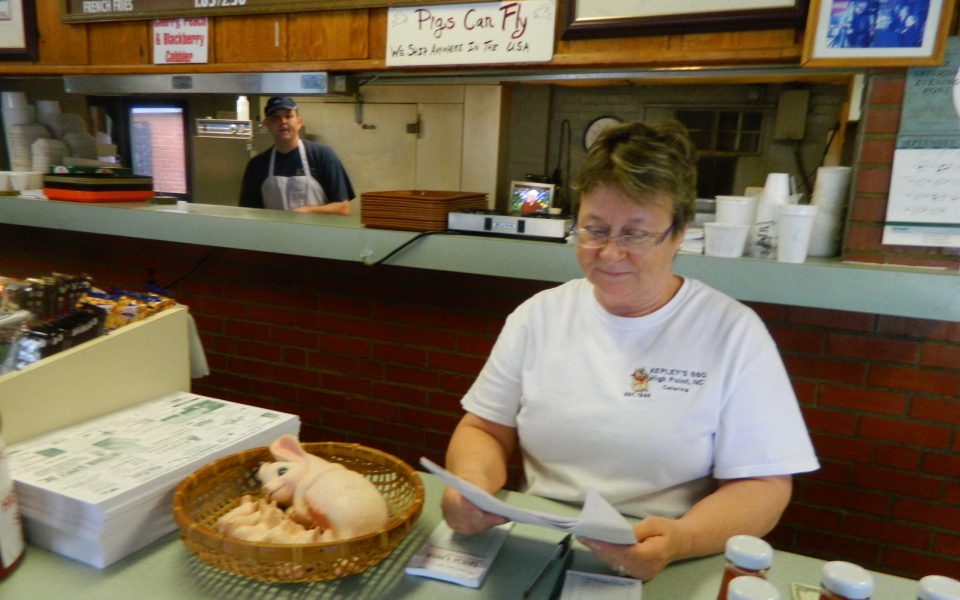by Jordan Green
A barbecue restaurant on North Main Street has collected hundreds of signatures opposing road dieting, but many business owners support the initiative.
Alan Ferguson was trimming roses behind the counter at the home-furnishings and floral-design store he owns on North Main Street. His small staff was slammed, preparing for two back-to-back events later this week.
“Boy, a lot of people aren’t liking it at all,” he said, referring to a proposal to reduce the number of lanes on the street that has recently that has created a low boil of controversy. “For us, they would be able to see us without flying by. Right now, they’re gone, and we’re forgotten.”
Few motorists heed the 35 mph posted speed limit on North Main Street. The street doubles as a state highway, funneling traffic from Interstate 74 south through Uptowne — the target area for the proposed “street dieting” project — and into the downtown furniture district and on to Archdale. A left-hand turn out of a parking lot requires a vehicle to dart across two lanes of quick-moving traffic. Walking across the street is a perilous proposition. The relative rarity of pedestrians attempting street crossings suggests that the auto-dominant design of the streets is an adequate deterrent.
Slowing down traffic and adding on-street parking that would not only accommodate motorists but provide a buffer for pedestrians could only help, Ferguson said.
“When people find us, they love us,” he said. “But they don’t see us when they fly by.”
Not all business owners have embraced the idea.
Kepley’s BBQ had collected about 220 signatures on a petition opposing the dieting of North Main Street as of Monday afternoon. The petition argues that the lane reduction would “create access problems for businesses in the area,” “deter traffic” and result in a loss of business during peak traffic periods, displace traffic into adjacent residential neighborhoods and impede emergency vehicles.
“Where is the traffic going to go?” asked Kepley’s cashier Kay Flannery. The vast majority of the restaurant’s clientele reaches the business by car rather than foot, she said. “There’s nothing here to walk to.”
That’s a common sentiment among some business owners and the wider public in High Point, although the five-block segment from Lexington Avenue to Parkway Avenue that is under consideration for the project supports a healthy cohort of restaurants, a nail salon, a jewelry store, a bar, an appliance store and a real estate office, among other enterprises.
High Point Transportation Director Mark McDonald said the city expects to complete a study in early November assessing the impact of reducing the number of lanes, both to North Main Street itself and to the adjacent neighborhoods. He said neither the High Point Fire Department nor Guilford County EMS, which services High Point Regional Hospital on nearby Elm Street, have raised any objections.
“We asked both our fire department and Guilford County EMS to attend the symposium we had in July,” McDonald said. “Our recollection is that neither fire nor Guilford EMS had any concerns about that. I think there would be some concern, but I don’t think they thought it would be anything insurmountable. They did attend the symposium.”
Chip Harris, the co-owner of Vintage Thrifts and Antiques located near the southern end of the North Main Street strip proposed for lane reduction offered a big-picture argument for street dieting.
“High Point at this point in time does not have a lot to offer in terms of a central place to gather, have festivals and eat out within a walkable district,” he said. “This section is the only place in town that has large neighborhoods on either side that could support it. North Main Street is ugly. It’s not attractive at all. It’s a raceway. With High Point not having a downtown due to the furniture market this would be a good place to do it.”
Ferguson, who owns the home furnishings and floral design store, bemoaned High Point’s lack of a year-round commercial center.
“We sold out the downtown to the furniture market, out of greed, I suppose,” he said. “I don’t see downtown ever being anything again. It was charming when I was growing up.”
Trying to attract customers on North Main Street has been “a nightmare,” he said, but better than the south side, where he did business previously.
Harris’ business partner and — come Sunday — his wife, Martha Ann Harris, said she would be happy with the results of a street diet, but worries that the construction phase will cause disruption. But she noted that when a lane was temporarily closed recently for work on a nearby stoplight, it produced a salutary effect.
“People were going by real slow, and you could see them pointing, like ‘I didn’t know that was there,’” she recalled.
The couple opened their store in their current location about two years ago. They have steadily built up their clientele through a print advertising although many passersby still appear oblivious to their business. As an indication of either their confidence or determination, they added a soda counter about six months ago.
Elijah Lovejoy, an events planner and who owns a rental house in High Point but recently moved to Greensboro with his family, has been helping the grassroots group We “Heart” High Point in its efforts to stimulate dialogue about the proposed street diet.
“It’s mind-boggling how commonplace it is in other cities and how controversial it is here,” he said. “It’s been done in Reidsville and Lexington, quite a long time ago actually. I would point folks like Kepley’s BBQ to South Elm Street in Greensboro. There’s a lot of evidence of restaurants thriving in a dieted environment.”
Lovejoy said he feels encouraged that elected leaders like Mayor Jim Davis are beginning to embrace the idea of street dieting, although there is significant disagreement about where it should happen. Lovejoy said he doesn’t concur with Davis’ idea that Kivett Avenue and English Road, which intersect Main Street north of the railroad tracks, are better candidates. The city needs to maximize its return on investment, he said.
“Main Street is the area everybody sees,” he said. “Using the analogy of your home: Don’t put all your money into fixing up your bedroom when more people are going to see your foyer and your living room.”
Lovejoy said a recent study found that roughly half of corporate executives who were offered jobs in High Point chose not to live in the city.
“One of the main reasons given,” he said, “is, ‘I wouldn’t want to live in a city with a main street that ugly.’”
Join the First Amendment Society, a membership that goes directly to funding TCB‘s newsroom.
We believe that reporting can save the world.
The TCB First Amendment Society recognizes the vital role of a free, unfettered press with a bundling of local experiences designed to build community, and unique engagements with our newsroom that will help you understand, and shape, local journalism’s critical role in uplifting the people in our cities.
All revenue goes directly into the newsroom as reporters’ salaries and freelance commissions.





First the “pro” proprietors here fail to see just where the ‘walking public” is to come from, as the area is backed by older single residence housing and has been for decades.
If folks aren’t shopping at their businesses it may have nothing to do with more traffic at all, and less of same may end up being worse.
Secondly, there is nowhere remotely likely for traffic actually going somewhere else (most of it) and not wanting to fight the already predescribed ” funnel” mentioned above made worse by the proposal, to go.
They could better increase “hang time ” in this stretch with one simple and arbitrary stop light added half way up the focus area, for millions of dollars less.
Third, don’t know about Reidsville but Lexington has done no such thing at all, though it has spiffed up it’s downtown area with some greenery, leaving it’s streets intact as they have always been.
Guess event planners are always in favor of tax paid new venues, for events.
Yep, fish favor water, as well.
This project is projected to cost roughly $12 million that the citizens here don’t have, and that is before the unavoidable and expensive adjacent and resultant fixes that it will later require.
This is a bad idea pushed by folks who want the rest of the city to pretty up an area that holds little draw now, and will hold less when the ability to navigate it is choked to a crawl.
What the heck, though, the taxpayers can always spend another fortune later to fix it, after the main players take their quick profits and are gone.
First, the street diet is an idea whose time has passed given NC’s tendency to follow trends rather than setting them.
Second, the debate over this one topic is dragging down the entire revitalization effort and could serve to nullify the entire Ignite High Point thing if the next City Council doesn’t do it first.
Finally, regarding Mr. Lovejoy’s view on Elm Street in Greensboro, that street has historically been two lanes downtown simply due to the high rises so there’s no way that it could ever been widened–if anything, Elm Street was at one point a one-way street through the CBD.